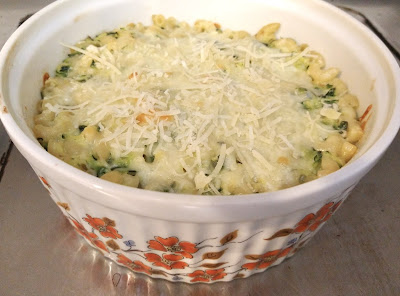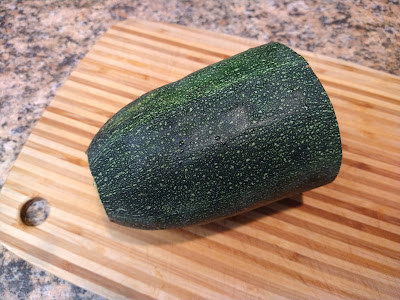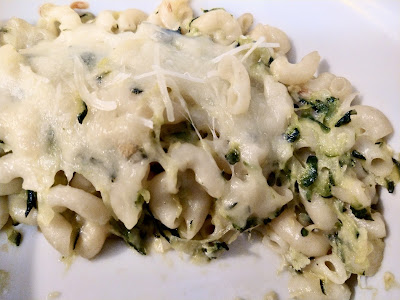
Recipe: 'Zucchini butter' holds together this baked macaroni

Zucchini mac, fresh from the oven.
(Photos: Debbie Arrington) |
It’s that time of year when my zucchini keeps growing faster than I can pick it. Little baby squash seem to turn into 2- or 3-pound specimens in less than a week.
When I measure a zucchini by the pound, that squash is best used grated, making the most of its moisture and fiber.
Grated zucchini is the basic ingredient in a wonderful summer pasta sauce. It’s rich, creamy and (I insist) good for you. (It’s green! It has to be!)
This sauce is a variation of Julia Child’s recipe for grated zucchini sautéed with shallots, also known as zucchini butter. It’s wonderful with all sorts of pasta – long, short or twisty.
Child nicknamed it “zucchini butter,” which is how it tastes. It also can be made with olive oil instead of butter; leave out the cream for a lighter version.
Since I have a lot of zucchini this summer, I started experimenting with zucchini butter. This combination was the best yet, using zucchini butter instead of heavy cheese sauce in a variation of mac and cheese.
 |
| This chunk of zucchini weighed exactly 1 pound. |
Zucchini mac
Makes 4 servings
Ingredients:
For sauce:
1 pound zucchini, grated (about 3 cups)
1 teaspoon salt
2 to 3 tablespoons butter
1/3 cup onion, finely chopped
½ cup cream
1 cup elbow macaroni (uncooked)
Water
Salt
Butter to grease baking dish
¼ cup Parmesan cheese, grated
Instructions:
Preheat oven to 350 degrees F.
Prepare zucchini. Grate squash with skin on. Remove any large hard seeds. Salt grated zucchini and place in a colander. Let drain at least 5 minutes, pressing down gently to remove excess moisture.
In a large skillet over medium heat, melt butter. Sauté onion in melted butter until soft. Add zucchini and sauté, stirring often, until most of the moisture is evaporated and the squash is very soft, about 5 minutes. Add cream and stir until blended. Bring to a boil, then reduce heat. Stir until slightly thickened, about 2 minutes. Remove from heat.
Meanwhile, prepare elbow macaroni according to package directions. Drain.
Add cooked macaroni to zucchini sauce in pan. Stir to combine.
Butter an 8-inch baking dish. Put zucchini-macaroni mixture into prepared dish. Sprinkle top with Parmesan cheese.

Bake at 350 degrees for 25 to 30 minutes, until cheese turns golden. Let cool 5 minutes before serving.
Comments
0 comments have been posted.Sacramento Digs Gardening to your inbox.
Food in My Back Yard Series
April 22: Should you stock up on fertilizer? (Yes!)
April 15: Grow culinary herbs in containers
April 8: When to plant summer vegetables
April 1: Don't be fooled by these garden myths
March 25: Fertilizer tips: How to 'feed' your vegetables for healthy growth
March 18: Time to give vegetable seedlings some more space
March 11: Ways to win the fight against weeds
March 4: Potatoes from the garden
Feb. 25: Plant a fruit tree now -- for later
Feb. 18: How to squeeze more food into less space
Feb. 11: When to plant? Consider staggering your transplants
Feb. 4: Starting in seed starting
Sites We Like
Garden Checklist for week of April 27
Once the clouds clear, get to work. Spring growth is in high gear.
* Set out tomato, pepper and eggplant transplants.
* From seed, plant beans, beets, cantaloupes, carrots, corn, cucumbers, melons, pumpkins, radishes and squash. Plant onion sets.
* In the flower garden, plant seeds for asters, cosmos, celosia, marigolds, salvia, sunflowers and zinnias. Transplant petunias, zinnias, geraniums and other summer bloomers.
* Plant perennials and dahlia tubers for summer bloom. Late April is about the last chance to plant summer bulbs, such as gladiolus and tuberous begonias.
* Transplant lettuce and cabbage seedlings.
* Weed, weed, weed! Don’t let unwanted plants go to seed.
* April is the last chance to plant citrus trees such as dwarf orange, lemon and kumquat. These trees also look good in landscaping and provide fresh fruit in winter.
* Feed citrus trees with a low dose of balanced fertilizer (such as 10-10-10) during bloom to help set fruit. Keep an eye out for ants.
* Apply slow-release fertilizer to the lawn.
* Thoroughly clean debris from the bottom of outdoor ponds or fountains.
* Start thinning fruit that's formed on apple and stone fruit trees -- you'll get larger fruit at harvest (and avoid limb breakage) if some is thinned now. The UC recommendation is to thin fruit when it is about 3/4 of an inch in diameter. Peaches and nectarines should be thinned to about 6 inches apart; smaller fruit such as plums and pluots can be about 4 inches apart. Apricots can be left at 3 inches apart. Apples and pears should be thinned to one fruit per cluster of flowers, 6 to 8 inches apart.
* Azaleas and camellias looking a little yellow? If leaves are turning yellow between the veins, give them a boost with chelated iron.
* Trim dead flowers but not leaves from spring-flowering bulbs such as daffodils and tulips. Those leaves gather energy to create next year's flowers. Also, give the bulbs a fertilizer boost after bloom.
* Pinch chrysanthemums back to 12 inches for fall flowers. Cut old stems to the ground.
* Mulch around plants to conserve moisture and control weeds.